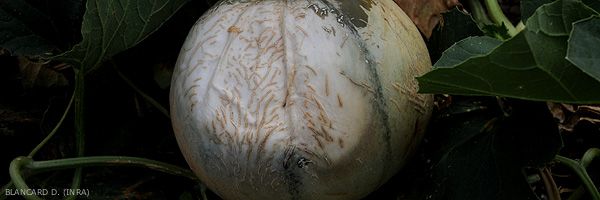
Climatic and environmental accidents
- Thermal stress
- Sunburn on fruits
- Physiological yellowing of fruits
This yellowing is the result of a local reaction of the bark exposed to the sun; it tends to fade as the fruit ripens. It should be noted that certain varieties are more sensitive to it, in particular the varieties with rather limited foliage, often of the monoecious sexual type.
- Leaf sunburn
This climatic accident has no consequences for the plants. In such a situation, it may be advisable to ventilate the shelters because the humid climate could favor the development of aerial pests.
- Corky stylar scar on fruit
This disease hardly affects the varieties of Charentais melon of the monoecious type, these varieties in general have a rather little marked stylar scar. On andromonoecious varieties where the scar is usually larger, it can be very detrimental.
- Crown and corky roots not parasitic
The roots and crown of the melon have a natural tendency to suberise easily when they encounter unfavorable environmental conditions in the soil, such as too low temperatures, for example, with or without excess water. The collar with the corky cortex also shows more or less significant longitudinal bursts (figure 6).
Thunderstorms accompanied by heavy rains and hail can cause lesions on all the aerial organs of the melon. In fact, hailstones, by striking the leaves, cause holes and tears which can greatly alter their photosynthetic potential subsequently, some leaves being completely shredded (figure 7).
Hailstones are also the cause of brownish necrotic changes, more or less pronounced bursts at their point of impact on the stem , petioles and peduncles (figure 8).
In general, the distribution in the crop of affected fruits will be generalized.
- wind Strong
The young wrinkled melon leaves, chewed by a strong wind, subsequently show necrotic inter-vein lesions (Figure 10). There will often be a lag between the effects of the wind and the expression of leaf symptoms which will be later on more developed leaf strata.
- Pollen deposits
Growers are sometimes surprised to observe a few tawny-colored spots on the surface of melon leaves and fruits. These are slightly raised and have a powdery appearance. When you rub them with your finger, you can see that they are in fact superficial deposits that can be removed very easily. Their origin can be easily elucidated: for this it suffices to observe the bees in the melon crops that they pollinate. Their legs are loaded with numerous aggregated pollen grains in the form of sometimes bulky "balls". The latter, when they have reached a certain size and during periods of wet weather, fall on the leaves (figure 12) and fruits (figure 13), particularly of melon or zucchini.





